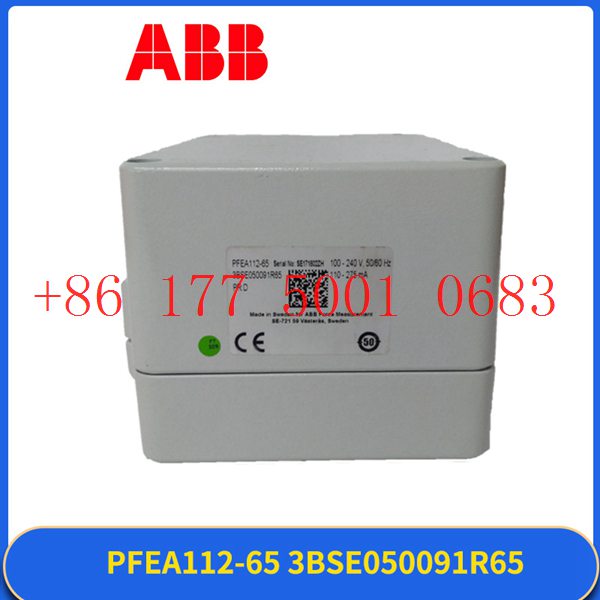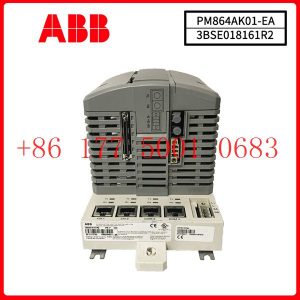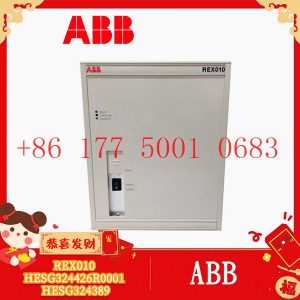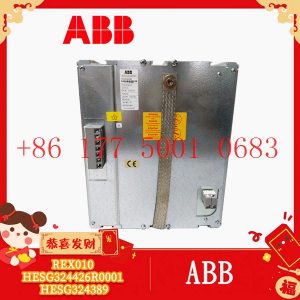Description
hardware flow control. It is an ideal choice in the field of industrial automation.
Implementation of communication between ABC industrial robot and PLC based on DeviceNet fieldbus technology
introduction
In modern production systems, industrial robots and PLCs need to communicate and collaborate to complete production tasks. That is, the
industrial robots output signals to the PLC, allowing the PLC to control related equipment to drive the robot”s front-end tools. This article
mainly analyzes the communication problems between ABB industrial robots and PLC based on DeviceNet fieldbus technology.
DeviceNet is a common network communication method in the field of automation. ABB industrial robots establish a network to communicate with
Siemens PLC based on the DeviceNet network.
1Configure DSQC652
There are mainly 5 types of standard I/0 boards commonly used in ABB industrial robots [2]. Except for the different addresses assigned to
them during setup, their configuration methods are basically the same. This article mainly analyzes the ABB standard I/0 board DS0C652, which
mainly builds communication modules based on the DeviceNet network. The DS0C652 board has a distributed I/O module with 16 digital input and 16
digital output interfaces. The board is installed in the ABB industrial robot control cabinet. First, define the specific operation steps of the DS0C652 board,
enter the teach pendant control panel, then enter the configuration menu (Figure 1), select the DeviceNetDevice menu, and add a template to enter Figure 2.
ABB standard I/0 board is hung on the DeviceNet
network, so the address of the module in the network must be set. The jumpers 6 to 12 of terminal x5 are used to determine the address of the module.
The available address range is 10 to 63. Modify the parameters in the template parameters to complete the DS0C652 board settings. Click the drop-down
menu to select the “Use value from template” row, select
“DS0C65224VDCI/0Device”, and then the parameters that need to be set include the address of the I/0 board in the bus.
Figure 1 Configuring DSQC652
2Configure signals and parameters
After completing the DS0C652 board setting, the I/0 signal setting will be performed. Setting the I/0 signal is the basis for establishing communication with
the PLC. The PLC communicates and transmits data with the ABB industrial robot through the I/0 signal and the DS0C652 board. As shown in Figure 3, in the
signal configuration interface, there are many default I/0 points after the system is established. Modification is not allowed. Click “Add” to add signals. When setting
input and output signals, their address range is 0~15. First, enter the signal menu in the configuration options to set the input and output types, and modify the corresponding parameters.
After completing the settings, the computer prompts that you need to restart the settings. If there are multiple signals that need to be defined and the waiting time
is long after restarting multiple times, you can click “Cancel” and wait for all signals to be defined before clicking the “Yes” button to restart. After the signal settings are
completed, click to select “Input and Output” in the ABB menu to check whether all signals have been set.
Figure 2 Configure DSQC652 parameters
Figure 3 Signal parameter settings
During the signal establishment process, attention should be paid to the DSoC652 port and PLC port addresses used, and the corresponding address table should be
established, as shown in Table 1. The robot interacts with the PLC through I/O signals. During the setting process, there must be no errors in the port and address number
of the PLC connected to the DSoC652. If the address is set incorrectly, the communication between the robot and the PLC will not work properly.
The entire robot teaching pendant setting process is shown in Figure 4.
https://www.xmamazon.com
https://www.xmamazon.com
https://www.plcdcs.com/
www.module-plc.com/
https://www.ymgk.com
PCM4.4 DEIF Differential current relay
7AT664.70 B&R AT664 Analog Input Module
PCM4.3 DEIF Differential current relay
FLN4234A MOTOROLA Controller MODULE
FLN3524A MOTOROLA Controller MODULE
05704-A-0144 HONEYWELL Four Channel Control Card Catalytic Input
JAPMC-IQ2303 YOKOGAWA 32 Input/Output Module
90088-A-9001 HONEYWELL power-supply module
TCPSV TOSHIBA
P0916AE FOXBORO Compression terminal assembly
IS220UCSAH1A GE Mark VIe Controller with a PMAC Processor
IS200HSLAH2ADE GE HS SLR LNK interface board
DSDX452 5716075-P ABB Remote In / Out Basic Unit
DL42N-22 SCHIELE Analog output module
330901-05-32-05-02-00 Bently Nevada
330180-90-05 Bently Nevada 3300 XL Proximitor Sensor
330130-080-00-00 Bently Nevada 3300 XL Standard Extension Cable
330108-91-05 Bently Nevada 5/8 mm Proximitor Sensor
135489-01 Bently Nevada I/O Module 4 Channel Internal Barrier
330103-00-03-05-02-05 Bently Nevada Sensor probe
190055 190055-0Z-01-01-01 Bently Nevada Monitor
PR937620 EPRO Axial vibration eddy current sensor
5466-316 Woodward High Performance Analog Combo
C002292.01/9100131600 VB-430 Vibro
VE4002S1T2B5 EMERSON Discrete Output Card
3604E TRICONEX 3604E Digital Output Modules 24VDC 16 Point TMR
SCXI-1125 NI 8-Channel Voltage Input Module
PMC-6130-J 0100RSDPMC-J MOTOROLA Processor module
PCD2.M48X SAIA
IE-4000-16GT4G-E Cisco Industrial Ethernet 4000 Series Switches
1747-ASB Allen-Bradley Universal Remote I/O Adapter Module
CS-1000 UTX1700PTFE MECE Wafer Robot Control System
BMEP585040 Schneider PROCESSOR MODULE
193-1CL00-0XA0 Siemens Terminal Block TB 32L
8C-PCNT01 51454363-175 HONEYWELL C300 Controller Module
PM866K02 3BSE050199R1 ABB Redundant Processor Unit
PM3398B-6P-1-3P-E PIONEER MAGNETICS power-supply module
LPF240A HITACHI power-supply module
51303940-150 HONEYWELL Cabinet Fan Assembly with Alarm
HIER464920P0001 ABB CURRENT RELAY,UNS 0017A-P
PXI-4071 NI PXI Digital Multimeter
AS-P892-000 Schneider PROCESSOR MODULE
104X905BA603 G-95-149-H-9550 GE
200-560-000-016 200-560-101-015 VIBRO









Reviews
There are no reviews yet.